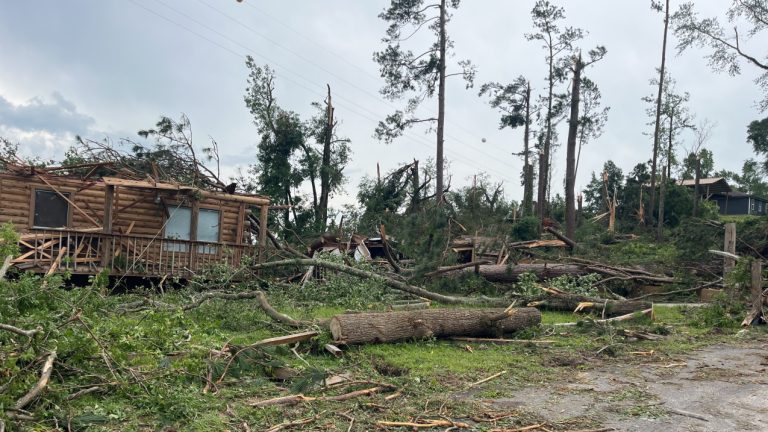June 2023 was record hot in some parts of the United States, while other locations were hit by extreme weather and poor air quality, according to experts from the National Centers for Environmental Information of the National Oceanic and Atmospheric Administration (NOAA).
The year so far has also brought 12 separate billion-dollar weather disasters to the country — including hurricane outbreaks, severe flooding and winter storms.
Here are more highlights from NOAA's monthly U.S. climate report for June:
Climate in numbers
June 2023
The average June temperature across the contiguous United States was 69.0°F (0.5° above average), ranking third in the 129-year climate record.
Temperatures were above average from the Pacific Northwest to the northern Plains, as well as in the southern Plains and the Florida peninsula. North Dakota had its third-warmest June on record, while Louisiana and Minnesota both had the 10-warmest Junes on record. Meanwhile, West Virginia and Virginia recorded the ninth and 10th coolest Junes on record, respectively.
June precipitation across the United States averaged 2.85 inches — 0.08 inches below average — ranking third in the middle third of the historical record.
Wisconsin and Michigan both had their fifth driest June on record, while Illinois and Missouri both had their top 10 driest Junes on record. Wyoming had its third wettest June on record, with Colorado and Maine having one of the 10 wettest Junes on record.
YTD (YTD, January to June 2023)
The year-to-date average temperature in the contiguous United States was 49.2 degrees Fahrenheit (1.7 degrees above the 20th century average), ranking it as the 21st warmest year-to-date. The January-June period in Florida ranked as the warmest on record, while Massachusetts had its second warmest period. Another 27 states recorded the 10 hottest temperatures since the beginning of the year, while no state experienced the top 10 coldest from January to June.
Total precipitation since the beginning of the year was 15.70 inches, 0.39 inches above average, which ranked third on record. Precipitation was above average from California to the Rocky Mountains and in parts of the southern Mississippi Valley, northern Great Lakes, Southeast, and Northeast. Conversely, precipitation was below average in parts of the northwest, northern, central and southwestern Plains, the central Mississippi Valley, the mid-Atlantic, and along portions of the Gulf Coast.
(Image credit: NOAA/NCEI)
Multi-billion dollar disasters (January-June)
There were 12 individual climate disasters worth $1 billion across the United States during the first six months of 2023, including:
- One winter storm occurred.
- One flood occurred.
- 10 severe weather events.
These events killed 100 people directly and indirectly, and caused losses exceeding $32.7 billion, after adjusting for the consumer price index. This puts the number of events this year and their costs second only to the first six months of 2017 ($14 disasters) and 2021 ($42.5 billion), respectively.
Since 1980, when the National Oceanic and Atmospheric Administration (NOAA) began tracking these events in the United States, the country has experienced 360 separate climate disasters where total damages/costs reached or exceeded $1 billion (based on CPI adjustment through 2023). For every event. The total cost of these 360 events exceeds $2.570 trillion.
(Image credit: NOAA/NCEI)
Other highlights in this report
- The temperature was on: A series of heat waves brought record temperatures to parts of the United States during June 2023.
- An early June heat wave brought life-threatening conditions to Puerto Rico with heat index values reaching 125 degrees Fahrenheit. On June 6, San Juan set a new daily temperature record of 95 degrees Fahrenheit.
- A heat wave brought record heat to parts of the Northeast, Mid-Atlantic and Great Lakes during early June. Record daily temperatures were recorded in parts of Michigan, New York and Vermont.
- The heat wave sent temperatures soaring above 100 degrees Fahrenheit across parts of the Southern Plains. On June 24, the temperature in Rio Grande Village, Texas, reached 119 degrees Fahrenheit, one degree below the highest temperature ever recorded in the state.
- Bad weather conditions struck several areas: A number of weather systems produced severe thunderstorms and tornadoes that affected parts of the United States in June.
- June 14-19: Tornado outbreaks, including two EF-3 tornadoes, occurred across portions of the southern United States and the Ohio Valley.
- June 16: A severe storm brought tornadoes and flash flooding to parts of Pensacola, Florida. Pensacola International Airport received more than nine inches of rain, surpassing the previous daily record set in 1985.
- June 20-26: More than 70 tornadoes were confirmed, including two EF-3 tornadoes, resulting in loss of life and widespread damage across parts of the Great Plains, Midwest, and eastern United States.
- Forest fires sent smoke south: Thick smoke from Canadian wildfires caused air quality issues for millions of people in parts of the country's Northeast and Great Lakes in June of this year.
- June 7: About 100 million people in 16 states were under air quality alerts while New York City reported the worst air quality among major cities worldwide.
- June 27: Wildfire smoke affects much of the Midwest, resulting in Chicago having the worst air quality among major cities worldwide.
More> Access NOAA's latest climate report and download images.

